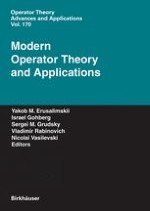(jointly with V.P. Zakharyuta and V.I. Yudovich), including a calculation of the capacity of condensers of complex form and dielectric materials with complex structure. In 1967, at the age of 32, six years after he defended his Ph.D. thesis, I.B. - monenko defended his thesis for a degree of Doctor of Science. In this thesis, entitled “Operators of local type and some other problems of the theory of linear operators,” he sharply turned towards the wide usage of the general methods of functional analysis. In 1971 professor I.B. Simonenko became the head of the - merical Mathematics Chair. The following year this chair was split into two; I.B. became the head of one of them, the Chair of Algebra and Discrete Mathematics. The Chair of Algebra and Discrete Mathematics can be rightfully called the Chair of I.B. Simonenko. Here he worked together with his colleagues, students, and the students of his students. Here he fully developed his teaching talent. He lectured on “Algebra and geometry,” “Mathematical logic,” “Discrete mathem- ics,” and “Mathematical analysis”.
